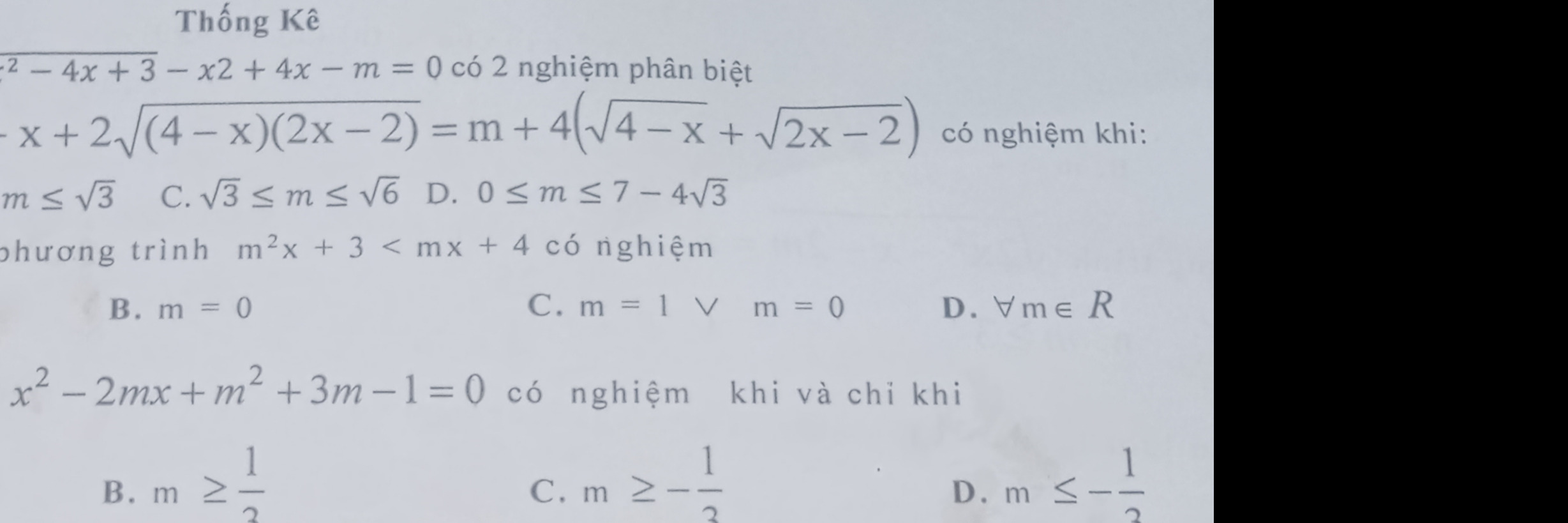Tìm điều kiện của số thực m để phương trình \(x^4+4x^3+4x^2-4|x^2+2x|+3m-5=0\)0 có 4 nghiệm phân biệt thuộc \([-3;2]\)
Hãy nhập câu hỏi của bạn vào đây, nếu là tài khoản VIP, bạn sẽ được ưu tiên trả lời.


1.
Đặt \(\sqrt{x^2-4x+5}=t\ge1\Rightarrow x^2-4x=t^2-5\)
Pt trở thành:
\(4t=t^2-5+2m-1\)
\(\Leftrightarrow t^2-4t+2m-6=0\) (1)
Pt đã cho có 4 nghiệm pb khi và chỉ khi (1) có 2 nghiệm pb đều lớn hơn 1
\(\Leftrightarrow\left\{{}\begin{matrix}\Delta'=4-\left(2m-6\right)>0\\\left(t_1-1\right)\left(t_2-1\right)>0\\\dfrac{t_1+t_2}{2}>1\\\end{matrix}\right.\)
\(\Leftrightarrow\left\{{}\begin{matrix}10-2m>0\\t_1t_2-\left(t_1+t_1\right)+1>0\\t_1+t_2>2\end{matrix}\right.\)
\(\Leftrightarrow\left\{{}\begin{matrix}m< 5\\2m-6-4+1>0\\4>2\end{matrix}\right.\) \(\Leftrightarrow\dfrac{9}{2}< m< 5\)
2.
Để pt đã cho có 2 nghiệm:
\(\Leftrightarrow\left\{{}\begin{matrix}m\ne3\\\Delta'=1+4\left(m-3\right)\ge0\end{matrix}\right.\)
\(\Leftrightarrow\left\{{}\begin{matrix}m\ne3\\m\ge\dfrac{11}{4}\end{matrix}\right.\)
Khi đó:
\(x_1^2+x_2^2=4\Leftrightarrow\left(x_1+x_2\right)^2-2x_1x_2=4\)
\(\Leftrightarrow\dfrac{4}{\left(m-3\right)^2}+\dfrac{8}{m-3}=4\)
\(\Leftrightarrow\dfrac{1}{\left(m-3\right)^2}+\dfrac{2}{m-3}-1=0\)
\(\Leftrightarrow\left[{}\begin{matrix}\dfrac{1}{m-3}=-1-\sqrt{2}\\\dfrac{1}{m-3}=-1+\sqrt{2}\end{matrix}\right.\)
\(\Leftrightarrow\left[{}\begin{matrix}m=4-\sqrt{2}< \dfrac{11}{4}\left(loại\right)\\m=4+\sqrt{2}\end{matrix}\right.\)

a) Ta có: \(\Delta=\left(-4\right)^2-4\cdot1\cdot\left(2m-3\right)=16-4\left(2m-3\right)\)
\(\Leftrightarrow\Delta=16-8m+12=-8m+28\)
Để phương trình có hai nghiệm x1;x2 phân biệt thì \(-8m+28>0\)
\(\Leftrightarrow-8m>-28\)
hay \(m< \dfrac{7}{2}\)
Với \(m< \dfrac{7}{2}\) thì phương trình có hai nghiệm phân biệt x1;x2
nên Áp dụng hệ thức Viet, ta có:
\(\left\{{}\begin{matrix}x_1+x_2=\dfrac{-\left(-4\right)}{1}=4\\x_1\cdot x_2=\dfrac{2m-3}{1}=2m-3\end{matrix}\right.\)
Để phương trình có hai nghiệm x1,x2 phân biệt thỏa mãn tổng 2 nghiệm và tích hai nghiệm là hai số đối nhau thì
\(\left\{{}\begin{matrix}m< \dfrac{7}{2}\\4+2m-3=0\end{matrix}\right.\Leftrightarrow\left\{{}\begin{matrix}m< \dfrac{7}{2}\\2m+1=0\end{matrix}\right.\)
\(\Leftrightarrow\left\{{}\begin{matrix}m< \dfrac{7}{2}\\2m=-1\end{matrix}\right.\Leftrightarrow\left\{{}\begin{matrix}m< \dfrac{7}{2}\\m=-\dfrac{1}{2}\end{matrix}\right.\Leftrightarrow m=-\dfrac{1}{2}\)
Vậy: Khi \(m=-\dfrac{1}{2}\) thì phương trình có hai nghiệm x1,x2 phân biệt thỏa mãn tổng 2 nghiệm và tích hai nghiệm là hai số đối nhau

\(\left\{{}\begin{matrix}x^2+2xy-3y^2=-4\left(1\right)\\2x^2+xy+4y^2=5\left(2\right)\end{matrix}\right.\)\(với\)\(y=0\Rightarrow hpt\Leftrightarrow\left\{{}\begin{matrix}x^2=-4\\2x^2=5\end{matrix}\right.\)\(\left(loại\right)\)
\(y\ne0\) \(đặt:x=t.y\Rightarrow hpt\Leftrightarrow\left\{{}\begin{matrix}t^2y^2+2ty^2-3y^2=-4\left(3\right)\\2t^2y^2+ty^2+4y^2=5\left(4\right)\end{matrix}\right.\)
\(\Leftrightarrow5t^2y^2+10ty^2-15y^2=-8t^2y^2-4ty^2-16y^2\)
\(\Leftrightarrow13t^2y^2+14ty^2+y^2=0\)
\(\Leftrightarrow13t^2+14t+1=0\Leftrightarrow\left[{}\begin{matrix}t=-\dfrac{1}{13}\\t=-1\end{matrix}\right.\)\(\Leftrightarrow\left[{}\begin{matrix}x=-\dfrac{1}{13}y\left(5\right)\\x=-y\left(6\right)\end{matrix}\right.\)
\(thay\left(5\right)và\left(6\right)\) \(lên\left(1\right)hoặc\left(2\right)\Rightarrow\left(x;y\right)=\left\{\left(1;-1\right);\left(-1;1\right);\left(-\dfrac{1}{\sqrt{133}};\dfrac{13}{\sqrt{133}}\right)\right\}\)
\(pt:x^4-4x^3+x^2+6x+m+2=0\)
\(\Leftrightarrow x^4-4x^3+4x^2-3x^2+6x+m+2=0\)
\(\Leftrightarrow\left(x^2-2x\right)^2-3\left(x^2-2x\right)+m+2=0\left(1\right)\)
\(đặt:x^2-2x=t\ge-1\)
\(\Rightarrow\left(1\right)\Leftrightarrow t^2-3t=-m-2\)
\(xét:f\left(t\right)=t^2-3t\) \(trên[-1;+\text{∞})\) \(và:y=-m-2\)
\(\Rightarrow f\left(-1\right)=4\)
\(f\left(-\dfrac{b}{2a}\right)=-\dfrac{9}{4}\)
\(\left(1\right)\) \(có\) \(3\) \(ngo\) \(pb\Leftrightarrow-m-2=4\Leftrightarrow m=-6\)


Câu 1:Ta có:
a) \(\left|x-3\right|=5\Leftrightarrow\left[{}\begin{matrix}x-3=5\\x-3=-5\end{matrix}\right.\Leftrightarrow\left[{}\begin{matrix}x=8\\x=-2\end{matrix}\right.\)
b) \(\left|2x+3\right|=2.\left|4-x\right|\)
+)Xét \(\left\{{}\begin{matrix}2x+3\ge0\\4-x\ge0\end{matrix}\right.\) \(\Leftrightarrow\dfrac{-3}{2}\le x\le4\)
Khi đó \(2x+3=2\left(4-x\right)\Leftrightarrow2x+3=8-2x\Leftrightarrow4x=5\Leftrightarrow x=\dfrac{5}{4}\left(tm\right)\)
+) Xét \(\left\{{}\begin{matrix}2x+3\ge0\\4-x\le0\end{matrix}\right.\) \(\Leftrightarrow x\ge4\)
Khi đó: \(2x+3=2\left(x-4\right)=2x-8\Leftrightarrow0x=-11\left(vl\right)\)
+) Xét \(\left\{{}\begin{matrix}2x+3\le0\\4-x\ge0\end{matrix}\right.\) \(\Leftrightarrow x\le\dfrac{-3}{2}\)
Khi đó: \(-\left(2x+3\right)=2.\left(4-x\right)\Leftrightarrow-2x-3=8-2x\left(vl\right)\)
+)Xét \(\left\{{}\begin{matrix}2x+3\le0\\4-x\le0\end{matrix}\right.\) \(\Leftrightarrow\left\{{}\begin{matrix}x\le\dfrac{-3}{2}\\x\ge4\end{matrix}\right.\) \(\left(vl\right)\)
Vậy...
c) ĐKXĐ : \(3-x\ge0\Leftrightarrow x\le3\)
+)Xét \(x^{^2}-3x+1\ge0\)
\(\Leftrightarrow x^2-3x+1=3-x\Leftrightarrow x^2-2x-2=0\)
\(\Leftrightarrow x^2-2x+1=3\Leftrightarrow\left(x-1\right)^2=3\)
\(\Leftrightarrow\left[{}\begin{matrix}x-1=\sqrt{3}\\x-1=-\sqrt{3}\end{matrix}\right.\)\(\Leftrightarrow\left[{}\begin{matrix}x=1+\sqrt{3}\left(tm\right)\\x=1-\sqrt{3}\left(tm\right)\end{matrix}\right.\)
+)Xét \(x^{^2}-3x+1\le0\)
\(\Leftrightarrow-\left(x^2-3x+1\right)=3-x\)
\(\Leftrightarrow x^2-3x+1=x-3\Leftrightarrow x^2-4x+4=0\)
\(\Leftrightarrow\left(x-2\right)^2=0\Leftrightarrow x-2=0\Leftrightarrow x=2\left(tm\right)\)
Vậy...
Câu 2:
Ta có:
Phương trình \(\left(x+3\right)\left(x^2-2x+m-1\right)=0\) có một nghiệm là \(x=-3\)
\(\Rightarrow\)Phương trình \(\left(x+3\right)\left(x^2-2x+m-1\right)=0\) có ba nghiệm phân biệt khi và chỉ khi \(x^2-2x+m-1=0\) có 2 nghiệm phân biệt và khác \(-3\)
Ta có: \(x^2-2x+m-1=0\) có 2 nghiệm phân biệt khi và chỉ khi \(\text{△}>0\Leftrightarrow8-4m>0\Leftrightarrow m< 2\)
Gọi \(x_1\) và \(x_2\) là 2 nghiệm của phương trình \(x^2-2x+m-1=0\).Theo hệ thức Vi-ét ta có:
\(\left\{{}\begin{matrix}x_1+x_2=-\dfrac{-2}{1}=2\\x_1x_2=\dfrac{m-1}{1}=m-1\end{matrix}\right.\)\(\Leftrightarrow\left\{{}\begin{matrix}x_1=2-x_2\\\left(2-x_2\right).x_2=m-1\end{matrix}\right.\)
Nếu \(x_2\ne-3\) thì \(m-1\ne-15\Leftrightarrow m\ne-14\).
Do vai trò của \(x_1\) và \(x_2\) là như nhau nên \(x^2-2x+m-1=0\) có 2 nghiệm phân biệt và khác \(-3\) khi và chỉ khi: \(\left\{{}\begin{matrix}m< 2\\m\ne-14\end{matrix}\right.\)

Bài 1:
a) Thay m=3 vào (1), ta được:
\(x^2-4x+3=0\)
a=1; b=-4; c=3
Vì a+b+c=0 nên phương trình có hai nghiệm phân biệt là:
\(x_1=1;x_2=\dfrac{c}{a}=\dfrac{3}{1}=3\)
Bài 2:
a) Thay m=0 vào (2), ta được:
\(x^2-2x+1=0\)
\(\Leftrightarrow\left(x-1\right)^2=0\)
hay x=1
